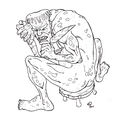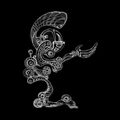Template:Selected anniversaries/April 22: Difference between revisions
No edit summary |
No edit summary |
||
| Line 15: | Line 15: | ||
||1797: Jean Léonard Marie Poiseuille born ... physicist and physiologist. He experimentally derived, and in 1840 and 1846 formulated and published, Poiseuille's law (now commonly known as the Hagen–Poiseuille equation, crediting Gotthilf Hagen as well), which applies to laminar flow, that is, non-turbulent flow of liquids through pipes of uniform section, such as blood flow in capillaries and veins. Pic. | ||1797: Jean Léonard Marie Poiseuille born ... physicist and physiologist. He experimentally derived, and in 1840 and 1846 formulated and published, Poiseuille's law (now commonly known as the Hagen–Poiseuille equation, crediting Gotthilf Hagen as well), which applies to laminar flow, that is, non-turbulent flow of liquids through pipes of uniform section, such as blood flow in capillaries and veins. Pic. | ||
||1809: William King - geologist at Queen's College Galway. He was the first (in 1864) to propose that the bones found in the German valley of Neanderthal in 1856 were not of Homo sapiens, but of a distinct species: Homo neanderthalensis. Pic. | |||
||1811: Ludwig Otto Hesse born ... mathematician. Hesse was born in Königsberg, Prussia, and died in Munich, Bavaria. He worked mainly on algebraic invariants, and geometry. The Hessian matrix, the Hesse normal form, the Hesse configuration, the Hessian group, Hessian pairs, Hesse's theorem, Hesse pencil, and the Hesse transfer principle are named after him. Pic. | ||1811: Ludwig Otto Hesse born ... mathematician. Hesse was born in Königsberg, Prussia, and died in Munich, Bavaria. He worked mainly on algebraic invariants, and geometry. The Hessian matrix, the Hesse normal form, the Hesse configuration, the Hessian group, Hessian pairs, Hesse's theorem, Hesse pencil, and the Hesse transfer principle are named after him. Pic. | ||
Revision as of 19:36, 7 January 2022
1592: Minister, scholar, astronomer, mathematician, cartographer, and inventor Wilhelm Schickard born. He will design and build calculating machines, and invent techniques for producing improved maps.
1779: Steganographic analysis of The Sleep of Reason Produces Monsters unexpectedly releases the Forbidden Ratio, which immediately begins to recruit a criminal gang made up of degenerate cases.
1833: Engineer and explorer Richard Trevithick dies. He was an early pioneer of steam-powered road and rail transport, developing the first high-pressure steam engine, and building the first full-scale working railway steam locomotive.
1904: American physicist and academic J. Robert Oppenheimer born. His achievements in physics will include the Born–Oppenheimer approximation for molecular wavefunctions, and the first prediction of quantum tunneling. Oppenheimer will be called the "father of the atomic bomb" for his role in the Manhattan Project.
1943: Cryptographer, intelligence officer, and APTO security consultant Edward Travis foils an attempt by the criminal mathematical function Forbidden Ratio to intercept telephone traffic to and from Bletchley Park.
1953: Singer-physicist J. R. Oppenheimer performs his hit song "Destroyer of Worlds" at the Grand Ole Opry, leading to his being summoned before the House Un-American Activities Committee.
1954: Red Scare: Witnesses begin testifying and live television coverage of the Army–McCarthy hearings begins.
1954: Writer and alleged troll Culvert Origenes testifies before the Senate Permanent Subcommittee on Investigations during the Army–McCarthy hearings. Origenes adamantly refuses to name other "alleged trolls", insisting that "there is nothing 'alleged' about trolls," and denouncing the investigation as "a witch-hunt, and not in a good way."
1970: The first Earth Day is celebrated.
1978: Optical fiber is first used to carry live telephone traffic.
1978: Mathematician, art critic, and alleged time-traveller The Eel escapes from the Nacreum, a high-security transdimensional prison, by transmitting himself over the new optical fiber telephone network.
2006: Computer scientist and academic Henriette Avram dies. She developed the MARC (Machine Readable Cataloging) format, the international data standard for bibliographic and holdings information in libraries.
2015: New study of the Toledo giant red ball incident blames the color red: "Of all the colors of the visible spectrum, red is the most likely to spontaneously generate artificial intelligence, which can quickly manifest itself as breaking away and rolling down the street."
2016: Physicist and academic Denys Wilkinson dies. Wilkinson's work in nuclear physics included investigation of the properties of nuclei with low numbers of nucleons. He was amongst the first to experimentally test rules relating to isospin. He also applied concepts from physics to the study of bird navigation. He invented the Wilkinson Analog-to-Digital Converter in the course of his experimental work.
2018: Signed first edition of Lend a Hand stolen from the Louvre by the Forbidden Ratio in a daring daytime robbery. Lend a Hand, which depicts an organic golem, had been in the Louvre for less than twenty-four hours.














